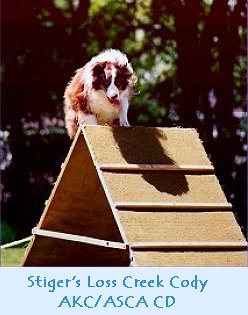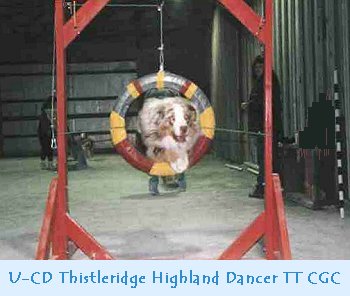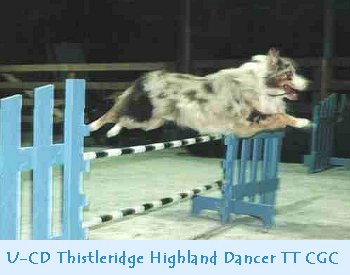
|

Agility

|
|
 Agility is one of the fastest growing dog sports today! It's fun, for both you and your dog. And, it's great for building a wonderful bond between the two of you.
Agility is one of the fastest growing dog sports today! It's fun, for both you and your dog. And, it's great for building a wonderful bond between the two of you.
History
The sport of agility began many years ago as a demonstration at the Crufts Dog Show in England. The organizers of the show went to a group of people, and asked them to put together something different for a demonstration during a break at the show. Several simple pieces of equipment were fashioned, and a few dogs were trained to navigate them. It was such a hit, they were asked to return the next year. With a whole year to plan and train, the demo the following year was much bigger! From there, agility grew into a sport. It's now seen world-wide, and there are international competitions.
The AKC and Agility
 The AKC jumped into the sport in 1995. Its program is a mix of the USDAA and the NCDA programs. Now, the AKC runs hundreds of trials a year, including championships. They even sponsored two teams to go to the World Championships in 1998, with the small dog team bringing home the gold!!
The AKC jumped into the sport in 1995. Its program is a mix of the USDAA and the NCDA programs. Now, the AKC runs hundreds of trials a year, including championships. They even sponsored two teams to go to the World Championships in 1998, with the small dog team bringing home the gold!!
The AKC's program was designed to allow all dogs of all breeds to participate. All you need is a happy, healthy AKC registered dog to compete in AKC agility trials. It is recommended that dogs are at least 1 year of age before starting serious training, since it is such a physically demanding sport. Also, dogs should be examined by a veterinarian prior to starting agility, to be sure they are in good enough condition.
AKC Agility
There are three basic levels of agility, and two titling programs. A dog starts in Novice, works its way through Open to Excellent. Once a dog earns its Excellent title, it can go on competing at the Excellent level for a Masters title, and eventually achieve an Agility Championship.
General information
 To earn a title, a dog must have 3 "qualifying scores", achieved under two different judges. A "qualifying score" is a minimun of 85 points out of a possible 100. Points are deducted for stopping before taking an obstacle (called a "refusal"), running past obstacles ("run out"), taking obstacles the wrong direction or in the wrong order ("wrong course"), or leaving the pause table too soon ("table fault"). All but table faults are 5 point deductions, a table fault is 2. Missing an obstacle completely, or not touching a required section on a contact obstacle are automaticly non-qualifying. Points are also deducted for every second the dog exceeds the "Standard Course Time" (SCT) of the measured, timed course. Each course is measured, and timed at so many yards per second, and it varies by class. Every point deduction is called a "fault".
To earn a title, a dog must have 3 "qualifying scores", achieved under two different judges. A "qualifying score" is a minimun of 85 points out of a possible 100. Points are deducted for stopping before taking an obstacle (called a "refusal"), running past obstacles ("run out"), taking obstacles the wrong direction or in the wrong order ("wrong course"), or leaving the pause table too soon ("table fault"). All but table faults are 5 point deductions, a table fault is 2. Missing an obstacle completely, or not touching a required section on a contact obstacle are automaticly non-qualifying. Points are also deducted for every second the dog exceeds the "Standard Course Time" (SCT) of the measured, timed course. Each course is measured, and timed at so many yards per second, and it varies by class. Every point deduction is called a "fault".
Novice Standard
At the novice level, dogs work towards earning their NA (Novice Agility) title. There are somewhere between 13 and 15 obstacles in a novice course. A typical "standard course time" for a novice course is between 65 and 70 seconds, which is actually quite a lot of time! In novice, only two refusals/runouts and two wrong courses are allowed. Each second over the SCT results in one point being deducted.
Novice A is for handlers who have not previously earned an Agility title, and Novice B is for handlers who have alrady eanred an agility title.
Open Standard
At the open level, dogs work toward their OA (Open Agility) title. In open, there are between 16 and 18 obstacles. A set of weave poles is added at this level. The number of yards allowed per second is longer, but the course itself is longer. Two points are deducted per second over the SCT. In open, only one refusals/run out, and two wrong courses are permitted. Obviously, it is harder for a dog to earn an OA title than a NA.
Excellent Standard
In Excellent A, dogs work toward their AX (Agility Excellent) title. Here, there are between 18 and 20 obstacles. There is only one refusal/run-out allowed. Courses are longer still in excellent. SCT is even shorter here than in open, and three points are deducted for each second over.
Once a Dog earns its AX, they continue to compete in the Excellent B class for advanced titles.
Masters and Champion titles
The MX (Master Agility Excellent) title is earned by continuing to show in the Excellent class, earning 10 additional qualifying scores.
The MACH (Master Agility Championship) is a new title to begin in February, 1999. To earn this title, dogs must achieve a minimum of 750 Championship Points and 20 Double Qualifying scores. One championship point is earned for each second under the SCT in a qualifying run in the Excellent B class. Points may be earned from both the Standard and the Jumpers courses (explained below). A dog who also wins first place in the class double the points earned that day, and the dog who takes second place multiplies their points by 1 1/2. One double qualifying score is earned by earning 100 points in both the Standard and Jumpers class at the same trial.
Jumpers With Weaves
 The JWW classes are the newest titling in AKC agility. Titles are earned in a similar way as in the standard classes. Three qualifying scores under two different judges are needed for the first three titles - NAJ (Novice Jumpers), OAJ (Open Jumpers), and AXJ (Excellent Jumpers). The fourth title, MXJ (Masters Jumpers) is earned by qualifying an additional 10 times in the Excellent B JWW class.
The JWW classes are the newest titling in AKC agility. Titles are earned in a similar way as in the standard classes. Three qualifying scores under two different judges are needed for the first three titles - NAJ (Novice Jumpers), OAJ (Open Jumpers), and AXJ (Excellent Jumpers). The fourth title, MXJ (Masters Jumpers) is earned by qualifying an additional 10 times in the Excellent B JWW class.
Equipment
The JWW classes consist of only jumps, weave poles and tunnels. There are no contact obstacles or pause table in these classes. The number of obstacles increases in each level. The same number of refusals/run-outs are allowed here as in the standard classes (except that they are not counted during the weave poles in Novice), but NO wrong courses are allowed at all. Without the contacts and table, SCTs here are much faster than in the Standard classes.
Training
Training for agility is a lot of fun. Corrections are not administered while the dog is learning. Dogs start simple and work their way up in difficulty. It is a gradual process.
To find a local training facility, contact the AKC for an affiliated club in your area.
By Sandra L. Walroth (Copyright 1998, 1999)

For more information on AKC agility, visit their web site, or go directly to their Agility Regulations.
NOTE: New Agility regulations will go into effect on February 1, 1999.

 Back to GLASC's Home Page Back to GLASC's Home Page
 For more information, write us. For more information, write us.

|
|







